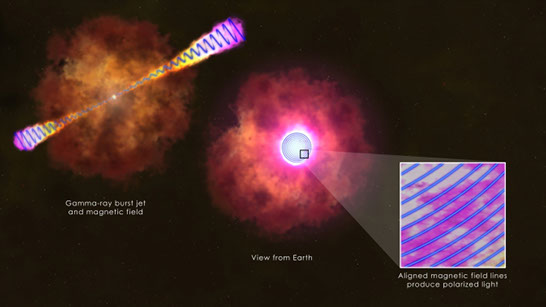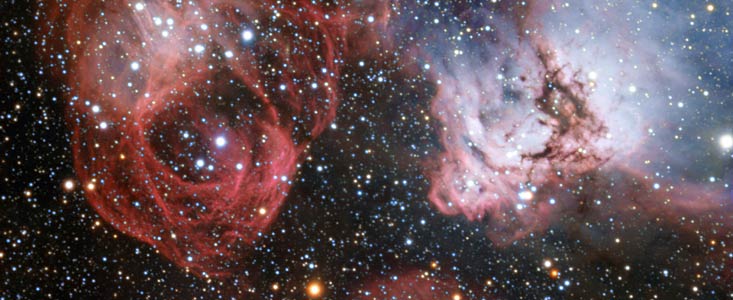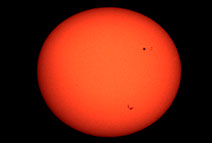



December 2013
Saturn
Cassini photographed a unique six-sided jet stream, known as the hexagon, around Saturn's north pole.
The hexagon is a wavy jet stream current of air with wind speeds of 322 kph (200 mph). There is a massive rotating storm at the center. The hexagon spans about 30,000 km (20,000 miles) across. There is no known weather feature like this anywhere else in the solar system.
The storm has been been raging for decades, maybe centuries. Scientists think that since Saturn does not have landmasses like the Earth does, there is nothing to interfere with the weather. Thus, storms can continue for very long periods of time uninterrupted.
Inside the hexagon there are fewer large particles in the atmosphere and a large concentration of small particles. Outside the hexagon, just the opposite occurs. The hexagon jet stream is acting like a barrier. This can be compared to the Earth's Antarctic ozone hole where, during winter, the jet stream blocks ozone from entering the region, creating a 'hole' in the ozone layer.
Cassini is getting its first good views of the polar region of Saturn now that the planet has entered Spring in the northern hemisphere and the sun is starting to shine on the region. Lighting conditions will continue to improve as Saturn heads towards its summer solstice in 2017, giving scientists excellent conditions to study the hexagon and the north polar region.

Visit our sponsors.
For advertising opportunities on this page and our videos, contact
Upcoming Launches
Date: December 17
Launch Vehicle: Antares
Launch Site: Wallops Flight Facility, Virginia
Description: Orbital 1 will be the first commercial resupply mission to the International Space Station
Image Credit: NASA/JPL-CalTch/SSI/Hampton
Image Credit: ESA/Plank Collaboration
Gamma-Ray Burst
An international team of astronomers from Britain, Slovenia and Italy have glimpsed the infrastructure of a gamma-ray burst's high speed jet. On March 8th 2012, NASA's Swift satellite detected a 100 second pulse of gamma-rays in the constellation Ursa Minor. The spacecraft immediately forwarded the location to observatories around the world. The 2-meter Liverpool Telescope located at Roque de los Muchachos Observatory in the Canary Islands was able to lock onto the burst within four minutes and took thousands of measurements over the next ten minutes.
Gamma-ray bursts are the most luminous explosions in the universe. They are thought to occur when a star runs out of fuel and collapses under its own weight. This forms a black hole which then drives jets of particles that drill all the way through the collapsing star and erupt into space at near the speed of light.
Energy moves out into space and begins to decelerate. This results in an outward moving shock wave. At the same time, a reverse shock wave is formed. This wave drives back into the jet debris producing a bright emission.
For the first time, scientists were able to measure the light only minutes after it happened. The initial measurement showed the light was polarized by 28 percent, the highest value ever recorded for a burst. This slowly declined to 16 percent, but the angle of the polarized light remained the same. This supports the presence of a large scale organized magnetic field linked to the black hole and rules out a tangled magnetic field produced by instabilities in the jet itself.

Large Magellanic Cloud
ESO's Very Large Telescope in Chile is exploring the Large Magellanic Cloud, one of the closest galaxies to our own. The Large Magellanic Cloud is located only 160,000 light years from us and can be seen with the naked eye. Here the birth and death of stars is played out.

On the right side of this photo is NGC 2035, the Dragon's Head Nebula. This is an emission nebula consisting of clouds of gas that glow due to the radiation given off by young stars. The electrons are striped from the atoms of gas and eventually recombine with other atoms and release light. This is where new stars are being born.
On the left of the photo is the result of stellar death. This nebula is the remains of a large supernova.
The Large Magellanic Cloud is much smaller than our Milky Way, about ten times smaller, at just 14,000 light years across.
Future Missions
The European Space Agency (ESA), has announced three new large scale missions. The missions were approved by the Science Policy Committee at their meeting in Paris.
Mission L2 will be an X-Ray telescope. Currently using the name Athena-plus, it will be about four tons in mass and have a 12 meter focal length. This will give it a sensitivity a hundred times better than today's best space telescope. Athena-plus will be used to study black holes and their origins, how they grow and how they influence their surroundings. Black holes are found at the center of almost all galaxies and understanding them will be one of the keys to understanding galaxy formations and evolution.
The X-Ray telescope is planned to launch in 2028.
Mission L3 will be a gravitational wave observatory. Currently it uses the name Lisa which stands for Laser Interferometer Space Antenna. It will fire lasers across millions of kilometers of space to search for ripples in the fabric of space-time which results from exploding stars and merging black holes. This mission will push the boundaries of current technology requiring an extreme precision gravitometer. ESA is about to launch a small satellite called Lisa Pathfinder to demonstrate some of the key technologies. The L3 Lisa mission is planned for 2034.
The first large scale mission, L1, was actually previously announced. Juice (JUpiter ICy moon explorer) is planned to launch on an Ariane rocket in 2022. Juice will study the planet Jupiter and its moons. Fly-bys of Callisto and Europa are planned and Juice will become the first spacecraft to orbit an icy moon - Ganymede, eventually crashing into its surface. The flight to Jupiter will take about eight years.
In addition to these long range missions, ESA has a large scale science mission ready to launch December 19. Gaia is a star-mapper program that has taken twenty years to develop.
The main member states contributing to these missions are Germany, the UK, France and Italy.
Sun
The magnetic poles of the sun are flipping places. The polarity of the north and south poles of the sun flip every eleven years. It happens at the peak of each solar cycle as the sun's inner magnetic dynamo re-organizes itself.
The polarity of the north and south poles of the sun flip every eleven years. It happens at the peak of each solar cycle as the sun's inner magnetic dynamo re-organizes itself.
LADEE
All systems are GO for LADEE to begin the science phase of its mission. The Lunar Atmosphere and Dust Environment Explorer (LADEE) was launched from NASA's Wallops Flight Facility in Virginia on September 6th and is currently in lunar orbit. NASA has completed the testing phase of the mission and all instruments are running normally.
The Lunar Dust Experiment (LDEX) will collect and analyze dust particles in the moon's atmosphere.
The Ultraviolet and Visible Light Spectrometer (UVS) will probe the composition of the moon's atmosphere.
The Neutral Mass Spectrometer (NMS) will measure variations in the lunar atmosphere.
In addition to the lunar science, LADEE includes a Lunar Laser Communications Demonstration (LLCD) payload. This uses a pulsed laser beam to transmit data instead of radio waves. It can transmit the data the 239,000 miles from the moon at a download rate of 622 megabits per second (Mbps). Upload rates transmitted from the primary ground station in New Mexico have been demonstrated at 20 Mbps. The goal of the demonstration is to validate and build confidence in the technology so future missions may consider using it.
As all systems are working, LADEE has completed its commissioning phase and has lowered its orbit to get closer to the moon to begin its 100 day science phase.
© 2014-2016 Ted Cook Productions LLC. - All Rights Reserved